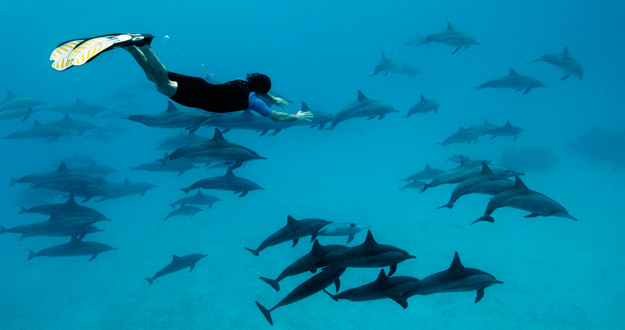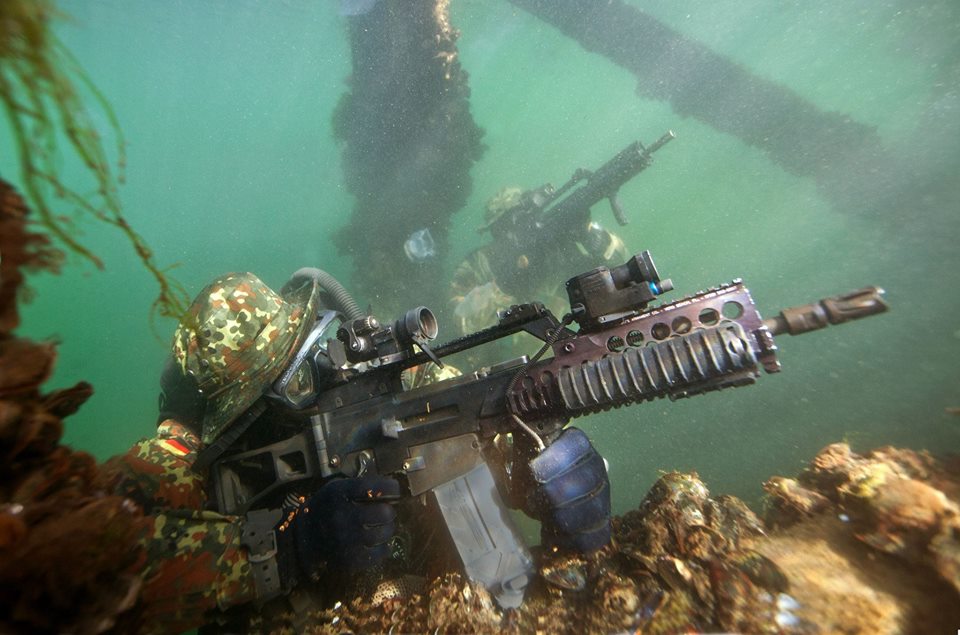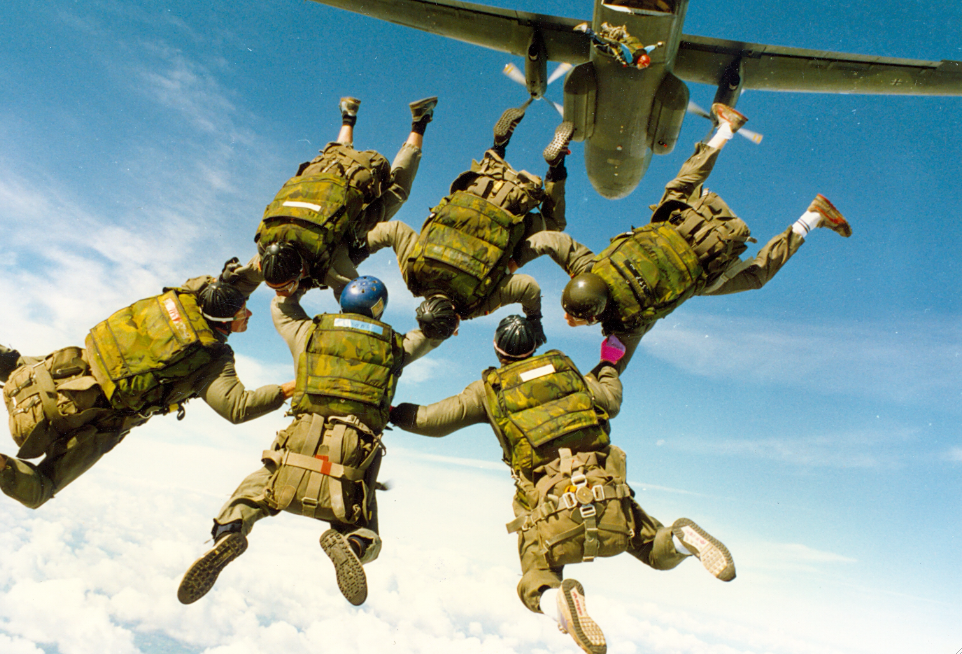
The mental and physical prerequisites for Kampfschwimmer service are the highest within the entire German armed forces. Candidates must be in the highest category (T1) of the physical screening test administered to military recruits. On a case by case basis candidates who fall in the second highest category (T2) of the physical screening test can be accepted; e.g. candidates who failed to make T1 because they are shorter than five feet, eight inches tall. Candidates must also successfully complete (or already have completed) military basic training, qualify for Boatswain training (the decision is made at the recruiting center in Wilhelmshafen), and pass a special physical screening test for diver and naval commando candidates. This day-long physical exam is conducted at the navy’s maritime medicine institute in Kiel/Kronshagen. All relevant health aspects are covered, including an eye exam, ENT, blood and urine tests, etc. Candidates are also placed in a hyperbaric chamber, and subjected to an oxygen tolerance test (breathing a gas mixture with a higher than normal proportion of oxygen). The latter test is one of the most frequent reasons candidates fail the physical. Diving gear routinely uses a higher than normal oxygen to nitrogen ratio. Either a candidate can tolerate it or he can’t. After the physical exam the applicant is interviewed by a psychologist. Both physical and mental suitability are prerequisites for admission to the training program. If the applicant meets these prerequisites he is transferred from his current unit or directly from basic training to the ship security training center in Neustadt/Holstein for the basic diving course. To qualify for the basic dive course candidates must: * pass the physical and psychological screening described above * run 5 kilometers within 25 minutes * swim 300 meters fully clothed within 8 minutes * perform a minimum of 3 pull-ups * dive to a depth of 5 meters and retrieve two rings weighing 5 kilos each * swim 25 meters underwater without surfacing * qualify for the lifesaving badge (in bronze) * pass the basic physical fitness test Once admitted to the training center at Neustadt the candidate is trained to become a professional-grade utility diver. The curriculum is demanding. Weather, the daily diving regimen, and long hours of strenuous activity require a robust constitution and stress tolerance. After successful conclusion of this 8 week course the candidate progresses to the special operations training company to begin Kampfschwimmer training. There his first challenge is another physical fitness test. Kampfschwimmer Entrance Exam (Physical Fitness) * run 5 kilometers within 22 minutes * swim 1,000 meters within 24 minutes *submerge for a minimum of 60 seconds * swim 30 meters underwater without surfacing (turning around halfway through) * perform a minimum of 8 pull-ups * Benchpress a minimum of 50Kg weight (15 repetitions) * (NOTE: the performance described above is the equivalent of a “D” grade (just barely passing)! A word of advice: all requirements should be exceeded. Given the extreme duress levels candidates will be exposed to throughout training, anyone who squeezes in with marginal qualifications is predestined to fail.) Only through completion of this “package” is the applicant deemed qualified to begin the first 12 month phase of Kampfschwimmer selection and training in Eckernförde.

LERNE LEIDEN OHNE ZU KLAGEN! – LEARN TO SUFFER IN SILENCE!
Is the motto of Kampfschwimmer training, and that pithy phrase really says it all. Candidates must display courage, unmitigated determination to succeed, willingness to learn, mental flexibility, capacity for suffering, humility, self-confidence, self discipline, leadership, responsibility, and the ability to work as part of a team. These are the prerequisites for embarking on the long and difficult road to becoming a “silent professional,” a fully trained Kampfschwimmer. In terms of the Big Five personality traits defined by psychologists, commando candidates require:
Enthusiasm and self-motivation, in order to acquire new skills and to overcome periods of adversity;
Openness for new experiences, in order to soak up new knowledge like a sponge;
Emotional stability, in order to remain calm and act sensibly during critical situations;
Conscientiousness, in order to become a reliable team member;
Agreeableness and compatibility, in order to maximize the potential of the Kampfschwimmer’s greatest asset: the TEAM (“two are one and one is none!”)
Welcome Civilian Experience:
A background in certain clubs and activities – e.g. a swim team – can help prepare people for life in a military community. Many naval commando candidates previously served as volunteers with non-profits such as the DLRG (German Lifeguard Organization, rescues mariners in coastal waters), water safety patrol, or the Red Cross. This reflects their dedication to service and their in-depth knowledge of first aid or waterborne operations. Scuba diving experience and theoretical or practical knowledge of boating and navigation help learn basic concepts and facilitate certain training segments. Martial arts are also appreciated. The German armed forces do not practice a common hand-to-hand combat system, and the various martial art techniques candidates have practiced constitute an enrichment.
Welcome Military Experience:
Prior service with Ranger, mechanized infantry or security force units facilitates comprehension of tactical concepts and fieldcraft. Previous tours of duty as a combat medic, communications specialist or reconnaissance specialist are beneficial for service with the Kampfschwimmer Company and for selecting further specialization. Experience operating drones – which are now regularly deployed by SOF – is another asset. Mastering these specialties can actually be a “job guarantor” for service members who want to stay with the SOF despite approaching the age limit or suffering diminished physical capacity. Nobody “retires on active duty” with the naval commandos.

Kampfschwimmer training lasts three years. Next to pilot training it is one of the longest, most expensive and physically most demanding training programs of the German armed forces. Aside from the overall physical and psychological burdens of the training, the element of water constitutes the trainees greatest challenge. This is what differentiates Kampfschwimmer training from all other training programs of the armed forces. Water saps the trainees’ strength, creates anxiety, and teaches humility.
The curriculum teaches the trainees to cope with constant cold and wetness, and to use the water’s characteristics to their own advantage. They learn to read surface and subsurface currents, the weather, wave and wind patterns, and to incorporate these into their mission planning. Kampfschwimmer live on, in, below and with the water. The water becomes their ally!
Another ally is the night. It surrounds, protects and hides the Kampfschwimmer’s actions in the water, on land or from the air. Both elements – water and darkness – enter the trainees life (usually simultaneously) on day one.
Water, darkness, cold and wetness are simultaneously the greatest stress factors. As is the fear of drowning, which is automatically guided by the Amygdala, the brain’s fear center. Jojtly these stressors influence thoughts and actions. Experience has shown that such stressors can break people. For that reason certain elements of training, when observed by outsiders, can appear inhumane. One example: being thrown into the water at night with arms and legs tied. This takes place under controlled conditions, with safety measures in place. But the trainee must rely only on himself. Passing this test provides a tremendous boost to moral and increases self-confidence.
In principle, training at this level – whether to become a naval commando, paratroop, or sharpshooter – is never a bad thing. But training only imparts the foundations, the basic skills, which enable the service member to take focused action. What counts is how these skills are construed and how they are applied later in training and in real-world operations. Another example: Kampfschwimmer candidates receive parachute training at the German armed forces’ airborne/airmobile school in Altenstadt, earning their formal qualification for manual opening parachute operations. Once assigned to the Kampfschwimmer unit, they will jump from aircraft wearing their complete dive gear, execute a perfect landing into the ocean, and execute a three hour underwater mission. During this mission they will covertly attach explosives to a ship, then egress undetected to the open sea to be picked up by a submarine. Good training provides the foundation for executing complex procedures.
In naval commando training, determination is the decisive factor: the will to learn, courage, perseverance, in short the stamina with which a goal is pursued. The level of determination will decide whether a candidate succeeds or gives up. The trainee must absorb knowledge like a sponge. Then he must have the courage and skill to call upon that learning and implement it at the right time and place. All Kampfschwimmer candidates receive the same training and are held to the same standards, but some prevail while other – sometimes physically much stronger – candidates don’t pass. Why is this so? No one really knows.
The progressive training or “easy to hard” principle is systematically applied in the Kampfschwimmer training program. Every day small deviations are inserted into familiar or already practiced routines; scenarios are expended. While this is practiced in all military training programs, it occurs faster in Kampfschwimmer training, incorporating more intense pressure and adding an additional stressor: uncertainty.
Only the instructors and leadership know where the training plan is headed. The trainees must learn to live with this uncertainty. Stress tolerance and acceptance of uncertainty lead to operators who can deal calmly and securely with disruptions in the field.

The shock of 9/11 2001 not only exposed the vulnerability of Western societies, it also identified the current threat which political institutions and the military need to confront head on.
In the course of the security policy debates and developments which followed the attacks in New York and Washington, the German Navy created a new unit unlike any other within the German armed forces. The Waffentauchergruppe was dissolved on 3 July 2003 and replaced by the Spezialisierte EinsatzKräfte der Marine (Specialized Operational Forces of the Navy), better known by their acronym SEK-M. It incorporated: command staff and logistics elements; the Kampfschwimmer Company; the Minentaucher or Mine Clearance Company; the Boarding Company; company-strength personnel forces for specialized naval operations; the training element for naval commandos, mine clearance personnel, and frigate-based boarding personnel; as well as four ocean-going vessels. In sum, the SEK-M became the central repository of capabilities which are unique not only within the fleet but withing the German armed forces overall.
Out-of-Area missions, which were still a novelty in the 1990s, are business-as-usual for the unit today. From its very formation – and up until this very hour – members of the SEK-M have been constantly deployed, sometimes at the squad or team level, and occasionally at the task force level. Little over a year after the unit stood up a new command and control policy for the German armed forces was introduced. The civilian and military leadership mandated a strict separation of command and control for conventional forces and SOF.
In September 2004 a separate SOF operations directorate was established in the German armed forces command staff; the doctrinal principles for implementing the new policies were presented in late 2004. On 15 March 2005 a joint top-level SOF Operations Command (Kommando Führung Operationen von SpezialKräften), best known by its acronym FOSK, was activated in Potsdam. This provided the requisite command structure for joint conduct and control of special operations missions at the operational level. In addition, the operational doctrine governing Kampfschwimmer operations was finalized. Within the framework of operational doctrine governing special operations forces, Kampfschwimmer responsibilities were formalized as: hostage rescue/ prisoner liberation missions; maritime missions; and the seaward portion special operations missions. The leadership structure for special operations forces was established in accordance with the applicable international standards based on NATO Special Operations Policy (MC 437). Responsibilities defined through the NATO Defence Planning Process and the European Headline Goal were also taken into consideration. For the naval special operations forces this meant, at the national level: maintaining the requisite readiness state and endurance capabilities to support the army’s KSK special operations forces in the maritime environment, in the course of “rescue and liberation” missions, and within the NATO and EU framework. Size, organization and capabilities of the force were prescribed, as were the three core mission areas for special operations units:
a) Special Surveillance and Reconnaissance
b) Direct Action
c) Military Assistance
For the naval special operations forces there also remained the additional requirement of being able to infiltrate and exfiltrate the area of operations by sea, air or land.
Establishing FOSK Command gave the naval commandos the command and control structure required for conducting sustained special operations. It was the German equivalent of the US Special Operations Command. During operations it was directly subordinated to the Generalinspekteur of the German armed forces (equivalent to the Chairman of the JCS).
FOSK Command draws on the resources of the Army’s KSK and the Navy’s SEK-M to assemble mission-tailored operational SOF task forces, and serves as their national command and control element. In addition to Special Operations Forces, these task forces can also include non-SOF tactical support units which have capabilities not embedded in the SOF units themselves. These augmentation units act as force enablers and force multipliers; frequently their contribution is essential in order to empower the SOF to carry out the primary mission. In this way the navy provides a double contribution to the mission force. On the one hand they provide the Kampfschwimmer as SOF, and on the other hand they provide submarines, aircraft and ships to provide direct tactical support as well as other support functions. The demands which FOSK Command placed on the special operations forces is reflected in the Kampfschwimmer Company’s newly defined mission statement.
In accordance witt NATO doctrine, European Union (EU) defense policy, and national operational doctrine, Special Operations Forces (SOF) are to be used for operations which – because of their special nature, goals, and the significance of the targets – must be conducted according to different principles and methods than those employed during missions by conventional forces. Overriding considerations may call for the employment of covert operations and the willingness to incur significant risk. Because of the intense demands placed upon SOF personnel, special efforts are made with regard to their selection, training and organization. They utilize special equipment and tactics suited to their specific mission profiles.
Special Operations Forces must fulfill three classes of missions:
* Special Reconnaissance and Surveillance: missions to gain specific, precisely defined and time-sensitive intelligence of strategic or operational significance and admissible as evidence in judicial proceedings.
* Direct Action (DA): offensive operations against point targets. These missions are clearly delimited in terms of operational space and mission duration. They are designed to minimize collateral damage. Mission goals can include destruction and sabotage, hostage rescue, seizure of materiel or of persons of interest, and physical occupation of the target location.
* Military Assistance: military operations to directly or indirectly improve the internal and external security and stability of recipient nations.
Because of their broad capabilities and mission-spectrum, special operations forces are viewed – both internationally and, in recent years, increasingly by Germany’s leadership – as strategically significant instruments of western security policy. The only tactical-level special operations forces within the German armed forces are the Army’s Special Operations Command (KSK – Kommando Spezialkräfte) and the Navy’s Kampfschwimmer. Ironically, the Kampfschwimmer have been in existence since 1959 but were not formally recognized as SOF until 2006, 49 years later.
On April 1 2012 the FOSK Command was transformed into the Operations Command. All ongoing military operations are now conducted under its auspices.
Today the Kampfschwimmer Company stands ready to apply is special operational capabilities with the maritime environment. The unit is also qualified for selected additional mission categories including maritime special reconnaissance, underwater tactical offensive operations, and opposed boarding operations (VBSS/ Visit Board Search and Seizure). They also augment the army SOF capabilities by conducting hostage rescue missions and capture of high-value targets in the maritime environment. Staging from ships and utilizing other seaborne platforms, the naval commandos can create the conditions which enable follow-on operations by army SOF. In this way the Kampfschwimmer also act as an additional link between the navy and the army. Led by FOSK Command, the Kampfschwimmer Company has demonstrated its capabilities in such recent and current missions as ATALANTA (European Union anti-piracy operations), Operation Enduring Freedom in Afghanistan, or as part of the International Security and Assistance Force. Whether afloat or far from the sea, operating openly or in the shadows, the German naval commandos have proven themselves a robust mission asset.

On 2 August 1990 some 100,000 Iraqi soldiers crossed into Kuwait. Within a few hours of this invasion the UN Security Council passed Resolution 660, condemning the invasion and demanding the withdrawal of the Iraqi forces. On 16 January 1991, one day after the ultimatum associated with UN Resolution 678 expired, the anti-Saddam coalition initiated massive airstrikes . On the evening of 17 January the land operations phase of Operation Desert Storm began.
The German contribution to this effort consisted of naval forces, including mine-warfare vessels which were deployed to reinforce NATO’s southern flank in the Mediterranean in what is considered the postwar German armed forces’ first out-of-area mission. On 6 March 1991, after combat operations had ceased in Iraq and Kuwait, the mine-warfare forces were relocated to the Persian Gulf to participate in mine clearing off the Kuwaiti coast. Members of the Kampfschwimmer Company were on board the German minesweepers. Their mission: secure the minesweeper detachment as well as high-profile individuals against terrorist attacks of any kind or magnitude.
While most of the company was tied up in this operation, a reorganization of the German Navy was taking place back home. This organizational reform, designed to reorient the armed forces for the post Cold War world, had significant (and challenging) consequences for the Kampfschwimmer, who lost their status as an “independent unit”. The Seebataillon was disestablished on 2 October 1991. In its stead the Waffentauchergruppe (“Armed Diver Group”) was established in Eckernförde as a subordinate unit of the Mine Warfare Forces Flotilla (Flottille der Minenstreitkräfte). It was composed of a headquarters platoon, the significantly downsized Kampfschwimmer Company, the Minentaucher Company (Mine Clearance Diver Company), a newly formed training company, and the minesweepers Mühlhausen and Langeoog. The training company was made up of the Kampfschwimmer training platoon, the underwater mine clearance training platoon and an EOD/IEDD platoon (Explosive Ordnance Disposal/Improvised Explosive Device Disposal).
In 1994 the naval commandos were finally able to fully utilize their expertise in boarding operations. These capabilities had been the subject of much controversy within the fleet, and had received very little official support up to this point. Fighting within the territory of the former Yugoslavia, prompted by the secession of Slovenia and Croatia, prompted NATO to establish the maritime surveillance mission OPERATION SHARP GUARD in the Adriatic. The Kampfschwimmer provided the German contribution to the Maritime Interdiction Force which was tasked with checking out so called Contacts of Interest (i.e. suspicious vessels).
In 1994, the Kampfschwimmer conducted their first ever boarding operations as part of the NATO-led maritime surveillance mission Operation Sharp Guard in the Adriatic Sea. Boarding skills – a prerequisite for effective embargo enforcement – were suddenly in high demand. While German naval vessels were quite capable of stopping ships, the fleet did not have organic boarding teams made up of armed specialists trained in fast rope, repelling, or hull climbing techniques. These capabilities – a prerequisite for boarding uncooperative vessels – had only been acquired and honed by the Kampfschwimmer. Their decision to perfect these skills (against considerable opposition from within the naval establishment) during the 1980s now proved prescient.
Limited berthing on the deployed frigates and destroyers precluded despatching complete Kampfschwimmer teams. When the frigates and destroyers were originally configured, boarding operations were not included in operational doctrine, and so no provisions were made for accommodating additional personnel beyond the regular crew. As a result the Kampfschwimmer ended up training members of the core crew – mostly navigation, bridge and engineering personnel – to serve as auxiliary members of the boarding team. These auxiliaries boarded the target vessel as a “second wave” following the commandos; they were employed as guards and took control of the bridge and engine room. A truly revolutionary step was employing reserve officers as Embargo Control Liasion Officers (ECLO). The ECLOs were usually former merchant mariners familiar with documentation carried aboard commercial vessels. This knowledge made them a great support asset for the boarding teams. The naval commandos had originally proposed introducing the ECLOs, and the idea had been quickly adopted.
During the mid-1990s the naval commandos trained the personnel of the German Navy’s Maritime Security Forces (Marinesicherungstruppen) in boarding procedures; the latter personnel would later assume full responsibility for boarding operations. In 2003 the Naval Special Operations Forces (Spezialeinsatzkräfte der Marine – SEK M) established a dedicated boarding company. (For details see Norman Bronch, “Ausbildung der Boardingssicherungssoldaten”, in Marine Forum, 5/2012)
Meanwhile, German army forces had been providing security assistance in Somalia since July 1993. In Decemner 1993 the German government decided to withdraw these troops by the end of March 1994. Withdrawal by air was ruled out because of the remaining threat level. This meant that the German navy had to evacuate the withdrawing forces by sea. And again it became evident that the navy lacked fleet security forces to protect ships in hostile environments. So the Kampfschwimmer were tasked, since they enjoyed organic tactical mobility (speedboats) and highly-trained snipers and counter-snipers. Their mission: protect the squadron and individual VIPs from terrorist attacks. The German army contingent boarded transport ships in the port of Mogadishu. The deployed Kampfschwimmer commandos were the last German military personnel to leave Somalia. Between operations in the Adriatic and East Africa, every member of the Kampfschwimmer Company was operationally deployed during 1994.
Meanwhile in 1994, Belgian paratroops had to evacuate German citizens from Rwanda, which was caught up in a genocidal civil war. On 14 March 1997 German armed forces evacuated 104 people (Germans as well as other nationals) from the German embassy in the Albanian capital Tirana. Both operations demonstrated that Germany suffered a capabilities gap with regard to rescue and evacuation missions. Establishment of the German army’s own own special operations unit, the brigade-sized Kommando Spezialkräfte (Special Operations Forces Command) or KSK, was, at least in part, an inescapable response to the fundamental changes in the changing mission spectrum facing the Bundeswehr in the mid-1990s. The German armed forces were facing a turning point. The had to evolve from a territorial defense force to an international expeditionary force. Especially during the early 1990s the Kampfschwimmer Company faced great challenges, being attached to other contingents and enduring long deployments. The unit’s small size and occasional use as a “911 force” exacerbated the difficulties. Insufficient knowledge about SOF operations and tactics (on the part of the conventional forces and/or commanders), inadequate equipment and transportation assets, and unfavorable operating environments came together to push the commandos to their very limits. The transformation of the armed forces into an expeditionary force – and the learning curve associated with that transformation – had serious consequences for the Kampfschwimmer Company.
Focused on the so called “Peace Dividend” following the end of the Cold War, the German armed forces lost interest in the Kampfschwimmer as an offensive tool of naval warfare. Suggestions to integrate the Kampfschwimmer of the former East German armed forces (which had developed excellent special boat units for commando transport) into the Kampfschwimmer Company, or combine both units into an evacuation squadron were immediately quashed.
The “Peace Dividend’s” resulted in a significant reduction in armed forces personnel strength; this impacted the Kampfschwimmer Company too. The number of enlisted personnel who were allowed to extend their commitments and become career sailors was curtailed. The Kampfschwimer lost more than fifty percent of their operational personnel. The damage to their force structure was so severe that it is still felt today, especially among the senior NCO ranks. Changes in organization, manpower and equipment, as well as a lack of support infrastructure, had reduced the once unique capabilities of the unit to a bare minimum.
The German armed forces as a whole underwent a transformational process in the 1990s. This transformation is reflected in the Kampfschwwimmer mission statement, which was amended to:
Operations against enemy port and coastal installations and vessels;
Reconnaissance of enemy ports, coastal installations, beaches and roadsteads;
Locating, identifying, and marking or demolition of underwater obstacles;
Participation in seaward security for ports and vessels;
Participation in EOD/EOR missions;
Beach and surf-zone reconnaissance and surveying.
Following dissolution of the Maritime Battalion in October 1991 the Kampfschwimmer Company remains the German armed forces only combat unit with expertise in amphibious operations. To satisfy the new, defensively oriented, mission spectrum the Kampfschwimmer unit increased its training for seaborne Combat Search and Rescue missions in support of NATO or UN operations. The SFOR mission underway at the time highlighted the need for such capabilities. German Tornado aircraft were conducting surveillance flights over the territory of the former Yugoslavia. Had there been a crash, the Kampfschwimmer would have been able to provide assistance. Their capabilities, in conjunction with the navy’s vessels and aircraft, made the navy he only German service branch capable of autonomously conducting such operations.
The unit’s EOD capabilities were also honed during this period. The company frequently detached individual explosive ordinance specialists for duty in the Balkans. With their specialized equipment and their personnel, the Kampfschwimmer quickly became a vital asset, operating independently or augmenting other units, wrote Thorsten Mathesius in his article “Die Kampfschwimmer – Zeitgerechte Antwort auf neue Herausforderungen” (“The Kampfschwimmer – A Timely Response to new Challenges”) in Marine Forum 11-1992.













































